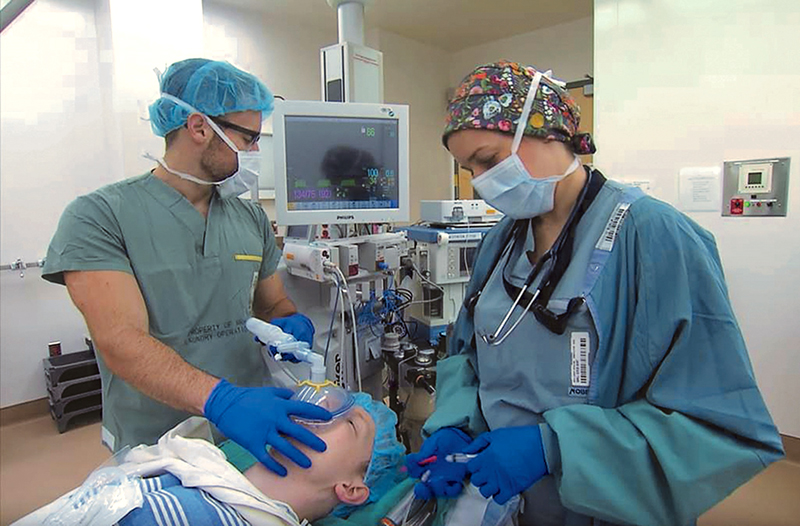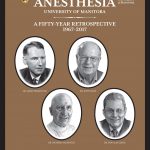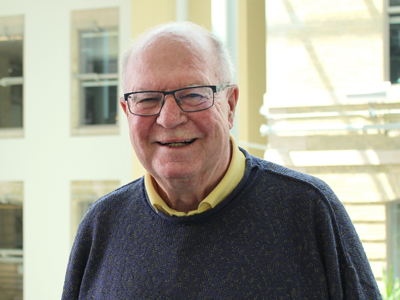
Book traces 50-year story of anesthesia at U of M
Dr. William Webster has been called the godfather of anesthesia at the U of M.
The British-born physician was the first full-time anesthetist at the Winnipeg General Hospital. In 1905, he started teaching anesthesia at the Manitoba Medical College, the forerunner of today’s Max Rady College of Medicine. In 1924, he published Canada’s first textbook in the field.
But Webster, who practised in the era of chloroform and ether, viewed his role very differently from how later generations would see theirs.
Webster believed that “the anesthetist had to be content to be the surgeon’s assistant,” writes historian Allan Levine in a new book, The Department of Anesthesia, University of Manitoba: A Fifty-Year Retrospective, 1967-2017.
That attitude, which was common throughout the world, would take decades to overcome. For many years, anesthesia at the U of M was a sub-department of surgery. The book traces the struggle to establish an independent department – with a residency program so trainees didn’t have to leave the province – and for anesthesia to be recognized as a full-fledged academic specialty.
 The book will have a public launch on June 17 at 7 p.m. in the John Buhler Research Centre Atrium on the Bannatyne campus, with many of the participants in the five-decade story in attendance. It can also be purchased, starting June 18, for $35 at the Health Sciences Bookstore in the Brodie Centre.
The book will have a public launch on June 17 at 7 p.m. in the John Buhler Research Centre Atrium on the Bannatyne campus, with many of the participants in the five-decade story in attendance. It can also be purchased, starting June 18, for $35 at the Health Sciences Bookstore in the Brodie Centre.
Dr. Chris Christodoulou, head of what is now the department of anesthesiology, perioperative and pain medicine (a recent name change reflecting the expanded scope of the specialty), says the time was right to hire Levine to dig into the archives, interview the key players and document the department’s history.

DR. CHRIS CHRISTODOULOU
“We wanted to reflect on the dynamic changes that have occurred, and create a lasting legacy of the lessons learned and the challenges we’ve worked through,” Christodoulou says.
Although the book uses the terms “anesthesia” and “anesthetist” for historical reasons, throughout Canada the specialty has largely adopted the terms used in the United States, “anesthesiology” and “anesthesiologist.”
When the long-awaited department was founded in 1967, a British anesthetist was hired to lead it. But he left after only 18 months, partly out of frustration that anesthesia was not yet a separate department at local hospitals.
Dr. John Wade, a Winnipegger who had trained in California, led the department from 1969 to 1979. “When I started, anesthesia was not held in high regard,” Wade recalls. “We were subservient to the surgeons. Some of the surgeons had a difficult time understanding that we had knowledge they didn’t have. But eventually, we gained a lot of credibility and respect.”

DR. JOHN WADE
In the 1970s, anesthetists became more assertive, cancelling surgery if they deemed it unsafe for the patient. They also sought improvements to their working conditions. It was recognized, for instance, that they were breathing in potentially harmful levels of anesthetic themselves. “We had to develop methods to vent the gases out of the operating rooms,” Wade says.
The book recounts an incident in which a British-trained anesthetist made a near-fatal error during a surgical procedure at St. Boniface Hospital. She was accustomed to machines on which the oxygen flowmeter was on the opposite side from its location on the Winnipeg machine.
Clearly, standardization of anesthesia practice was needed for patient safety. Manitoba experts were involved in establishing Canadian guidelines in 1977. “We did it about 10 years before the Americans,” Wade says.
From 1973 to 1984, the U of M department operated a unique-in-Canada sheep research lab in the basement of the medical college. Anesthetists used pregnant sheep to investigate questions such as what effect obstetrical anesthetics had on the fetal brain. They published a number of notable findings.
In 1994, a group of Winnipeg anesthetists brought forward a grave concern: too many babies and young children were not surviving cardiac surgery at the Children’s Hospital. Ultimately, an inquest into the deaths of 12 children, all operated on by the same surgeon, found that many of the tragic outcomes could have been prevented if the hospital had taken action sooner.
“It took tremendous moral and ethical courage to raise those concerns,” Christodoulou says. “It highlights our responsibility to advocate for patient safety.”
Today, Christodoulou says, the U of M’s five-year residency program continues to produce top-notch anesthesiologists and the department has a reputation for excellence in patient care, teaching and research.
“After 50 years, our ability right now to push the boundaries of knowledge creation, scientific discovery, innovation, academic leadership and excellence is unprecedented.”







Hi Alison, Dr. James Krahn here, class of 1982,
can you ask Chris to remind me or maybe it’s in this history book, an anesthetist I think named Chris,in the 1980’s, one of our teachers, German accent, surname began with W. I believe, can’t quite retrieve the full name, joked with us as a class telling a humorous story about ether. Funny request eh? THX!!